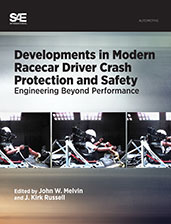Journal Article
Assessment of the 50th Hybrid III Responses in Blunt Rear Impacts to the Torso
2021-04-06
2021-01-0919
Blunt impacts to the back of the torso can occur in vehicle crashes due to interaction with unrestrained occupants, or cargo in frontal crashes, or intrusion in rear crashes, for example. Six pendulum tests were conducted on the back of an instrumented 50th percentile male Hybrid III ATD (Anthropomorphic Test Device) to determine kinematic and biomechanical responses. The impact locations were centered with the top of a 15-cm diameter impactor at the T1 or at T6 level of the thoracic spine. The impact speed varied from 16 to 24 km/h. Two 24 km/h tests were conducted at the T1 level and showed repeatability of setup and ATD responses. The 16 and 24 km/h tests at T1 and T6 were compared. Results indicated greater head rotation, neck extension moments and neck shear forces at T1 level impacts. For example, lower neck extension was 2.6 times and 3.8 times greater at T1 versus T6 impacts at 16 and 24 km/h, respectively.

